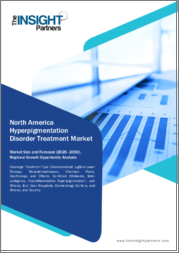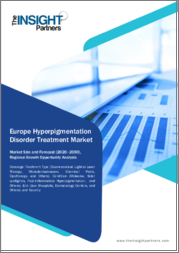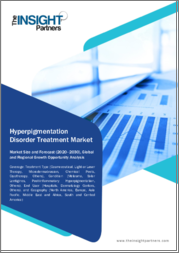
|
시장보고서
상품코드
1517320
세계의 색소침착 치료 시장 규모 조사 : 치료 유형별, 질환 유형별, 최종사용자별, 지역별 예측(2022-2032년)Global Hyperpigmentation Treatment Market Size Study, by Treatment Type, by Disorder Type, by End User and Regional Forecasts 2022-2032 |
||||||
세계 색소침착 치료 시장은 2023년 약 54억 8,000만 달러로 평가되며, 2024년부터 2032년까지 예측 기간 동안 연평균 7.6%의 견조한 성장세를 보일 것으로 예상됩니다.
색소침착은 멜라닌의 과잉 생산으로 인해 피부가 검게 변하는 것을 말하며, 기미, 염증 후 색소침착, 흑점 등의 증상을 유발합니다. 색소침착 치료 시장에는 하이드로퀴논, 레티노이드, 식물 추출물 등의 성분을 함유한 외용 크림부터 고급 레이저 치료 및 화학적 필링에 이르기까지 다양한 제품과 시술이 포함됩니다. 색소침착 치료 제품의 기술 발전도 시장 성장의 원동력이 되고 있습니다. 나노기술과 같은 기술 혁신은 피부 침투성과 생체 이용률을 향상시킴으로써 일반적인 색소침착 치료의 효능을 높이고 있습니다. 예를 들어, 나노입자는 멜라닌 생성 세포에 활성 성분을 정확하게 전달할 수 있어 보다 표적화되고 효율적인 치료 접근법을 보장합니다. 이러한 발전은 예측 기간 동안 색소침착 치료 시장의 성장을 촉진할 것으로 예상됩니다.
시장의 성장은 주로 피부 관리에 대한 인식의 증가, 소셜 미디어가 미용 기준에 미치는 영향력, 색소침착 치료 제품의 효능을 향상시키는 색소침착 치료 제품의 기술적 진보에 의해 주도됩니다. 예를 들어, 국립 의학 도서관이 2022년에 보고한 바와 같이, 새로운 약리학적 치료제는 국소 메트포르민, 플루타미드, 이소부틸아미드 티아졸리 레졸시놀, 혈소판풍부혈장 등 기미와 염증 후 색소침착을 치료할 수 있는 새로운 약리학적 치료제를 포함합니다. 또한 세계보건기구(WHO)에 따르면 2050년까지 21억 명에 달할 것으로 예상되는 노인 인구의 증가는 색소침착과 같은 피부과적 문제에 대한 노인의 민감성 증가로 인해 시장 성장의 원동력이 되고 있습니다. 피부 관리에 대한 인식이 높아지고 소셜 미디어가 아름다움의 기준에 영향을 미치면서 색소침착 치료 제품에 대한 수요가 크게 증가하고 있습니다. 소비자들은 점점 더 많은 국소 크림, 세럼, 화학적 필링, 레이저 치료와 같은 혁신적인 솔루션을 찾고 있으며, 이는 짙은 기미를 옅게 하고 피부 톤을 균일하게 하며 피부 광채를 되찾아줄 수 있는 혁신적인 솔루션을 찾고 있습니다. 전문적인 치료를 제공하는 스킨케어 브랜드와 클리닉의 확장은 시장 성장에 더욱 기여하고 있습니다.
세계 색소침착 치료 시장을 조사한 주요 지역은 북미, 유럽, 아시아태평양, 라틴아메리카, 중동 및 아프리카입니다. 북미는 2023년에 가장 큰 시장 점유율을 차지했습니다. 이러한 성장의 원동력은 피부 관리 기술의 발전, 미용 시술에 대한 인식과 수용성 증가, 효과적이고 안전한 치료 옵션에 대한 수요 증가입니다. 인구 고령화, 기미 및 염증 후 색소침착을 포함한 피부 질환의 유병률 증가, 피부과 치료의 발전 등 치료적 요인이 시장 성장에 기여하고 있습니다. 또한, 북미 색소침착 치료 시장에서 주요 제약사, 스킨케어 브랜드 및 피부과 클리닉이 중요한 역할을 하고 있습니다. 또한, 아시아태평양은 2024년부터 2032년까지 예측 기간 동안 가장 높은 성장률을 보일 것으로 예상됩니다.
목차
제1장 색소침착 치료 세계 시장 : 주요 요약
- 색소침착 치료 세계 시장 규모와 예측(2022-2032년)
- 지역별 개요
- 부문별 개요
- 치료 유형별
- 질환 유형별
- 최종사용자별
- 주요 동향
- 경기후퇴의 영향
- 애널리스트의 결론과 제안
제2장 세계의 색소침착 치료 시장 정의와 조사 가정
- 조사 목적
- 시장 정의
- 조사 가정
- 포함과 제외
- 제한사항
- 공급측 분석
- 입수 가능성
- 인프라
- 규제 환경
- 시장 경쟁
- 경제성(소비자의 관점)
- 수요측 분석
- 규제 프레임워크
- 기술의 진보
- 친환경
- 소비자 의식과 수용
- 조사 방법
- 조사 대상 연도
- 통화 환산율
제3장 세계의 색소침착 치료 시장 역학
- 시장 성장 촉진요인
- 스킨케어에 대한 인식 확산
- 소셜 미디어가 미 기준에 미치는 영향 높이
- 치료 제품의 기술적 진보
- 시장 과제
- 원재료 가격 변동
- 첨단 치료법의 고비용
- 시장 기회
- 노인 인구 증가
- 제품 처방과 전달 방법 혁신
제4장 세계의 색소침착 치료 시장 : 산업 분석
- Porter's Five Forces 모델
- 공급 기업의 교섭력
- 구매자의 교섭력
- 신규 참여업체의 위협
- 대체품의 위협
- 경쟁 기업 간의 경쟁 관계
- Porter's Five Forces 모델로의 미래지향적 접근법
- Porter's Five Forces의 영향 분석
- PESTEL 분석
- 정치
- 경제
- 사회
- 기술
- 환경
- 법률
- 주요 투자 기회
- 주요 성공 전략
- 파괴적 동향
- 업계 전문가의 관점
- 애널리스트의 결론과 제안
제5장 색소침착 치료 세계 시장 규모와 예측 : 치료 유형별, 2022-2032년
- 부문 대시보드
- 색소침착 치료 세계 시장 : 치료 유형별, 매출 동향 분석, 2022년·2032년
- 국소약
- 광치료
- 미세박피
제6장 색소침착 치료 세계 시장 규모와 예측 : 질환 유형별, 2022-2032년
- 부문 대시보드
- 색소침착 치료 세계 시장 : 질환 유형별, 매출 동향 분석, 2022년·2032년
- 검버섯
- 기미
- 기타
제7장 색소침착 치료 세계 시장 규모와 예측 : 최종사용자별, 2022-2032년
- 부문 대시보드
- 색소침착 치료 세계 시장 : 최종사용자별, 매출 동향 분석, 2022년·2032년
- 병원
- 피부과 클리닉
- 기타
제8장 색소침착 치료 세계 시장 규모와 예측 : 지역별, 2022-2032년
- 북미의 색소침착 치료 시장
- 미국의 색소침착 치료 시장
- 캐나다의 색소침착 치료 시장
- 유럽의 색소침착 치료 시장
- 독일의 색소침착 치료 시장
- 영국의 색소침착 치료 시장
- 프랑스의 색소침착 치료 시장
- 이탈리아의 색소침착 치료 시장
- 기타 유럽의 색소침착 치료 시장
- 아시아태평양의 색소침착 치료 시장
- 중국의 색소침착 치료 시장
- 인도의 색소침착 치료 시장
- 일본의 색소침착 치료 시장
- 한국의 색소침착 치료 시장
- 기타 아시아태평양의 색소침착 치료 시장
- 라틴아메리카의 색소침착 치료 시장
- 브라질의 색소침착 치료 시장
- 멕시코의 색소침착 치료 시장
- 기타 라틴아메리카의 색소침착 치료 시장
- 중동 및 아프리카의 색소침착 치료 시장
- 사우디아라비아의 색소침착 치료 시장
- 남아프리카공화국의 색소침착 치료 시장
- 기타 중동 및 아프리카의 색소침착 치료 시장
제9장 경쟁 정보
- 주요 기업 SWOT 분석
- 주요 시장 전략
- 기업 개요
- Pierre Fabre S.A.
- 주요 정보
- 개요
- 재무(데이터 가용성에 따라 다름)
- 제품 개요
- 시장 전략
- Areolase Corporation
- Candela Corporation
- SkinBase
- EpiPharm AG
- Galderma S.A.
- Alchemee LLC
- Allergan Aesthetics
- AMBI Skincare
- Procter & Gamble
- Unilever
- Johnson & Johnson
- Episciences Inc.
- Vivier Pharma
- L'Oreal Group
- Pierre Fabre S.A.
제10장 조사 과정
ksm 24.08.02The Global Hyperpigmentation Treatment Market was valued at approximately USD 5.48 billion in 2023 and is projected to grow at a robust CAGR of 7.6% over the forecast period from 2024 to 2032. Hyperpigmentation refers to the darkening of the skin caused by the overproduction of melanin, leading to conditions such as melasma, post-inflammatory hyperpigmentation, and sunspots. The market for hyperpigmentation treatment includes a diverse range of products and procedures, ranging from topical creams containing ingredients such as hydroquinone, retinoids, and botanical extracts to advanced laser therapies and chemical peels. Technological advancements in hyperpigmentation treatment products are also driving market growth. Innovations such as nanotechnology are enhancing the efficacy of common hyperpigmentation active ingredients by improving their skin penetration and bioavailability. For instance, nanoparticles enable the precise delivery of active ingredients to melanin-producing cells, ensuring a more targeted and efficient therapeutic approach. These advancements are expected to drive the hyperpigmentation treatment market growth over the forecast period.
The market's growth is primarily driven by an increasing awareness about skincare, the high impact of social media on beauty standards, and technological advancements in hyperpigmentation treatment products that enhance product effectiveness. For instance, emerging pharmacological therapeutics include topical metformin, flutamide, isobutylamido thiazolyl resorcinol, and platelet-rich plasma for treating melasma and post-inflammatory hyperpigmentation, as reported by the National Library of Medicine in 2022. Additionally, the rising geriatric population, expected to reach 2.1 billion by 2050 according to the World Health Organization, is also driving market growth due to the increased susceptibility of older individuals to dermatological concerns such as hyperpigmentation. The growing awareness about skincare and the influence of social media on beauty standards have significantly increased the demand for hyperpigmentation treatment products. Consumers are increasingly seeking out innovative solutions, such as topical creams, serums, chemical peels, and laser therapies, that promise to fade dark spots, even skin tone, and restore radiance. The expanding range of skincare brands and clinics offering specialized treatments has further contributed to the market's growth.
The key regions considered for the Global Hyperpigmentation Treatment Market study include North America, Europe, Asia Pacific, Latin America, and the Middle East and Africa. North America accounted for a significant market share in 2023. This growth is driven by advancements in skincare technology, increasing awareness and acceptance of cosmetic procedures, and rising demand for effective and safe treatment options. Factors such as an aging population, rising incidences of skin disorders, including melasma and post-inflammatory hyperpigmentation, and advancements in dermatological treatments contribute to market growth. Moreover, Major pharmaceutical companies, skincare brands, and dermatology clinics play significant roles in the North America hyperpigmentation treatment market. Furthermore, The Asia-Pacific region is projected to experience the highest growth rate during the forecast period 2024-2032.
Major market players included in this report are:
- Episciences Inc.
- Vivier Pharma
- Pierre Fabre S.A
- L'Oreal Group
- Areolase Corporation
- Candela Corporation
- SkinBase
- EpiPharm AG
- Galderma S.A.
- Alchemee LLC
- Allergan Aesthetics
- AMBI Skincare
- Procter & Gamble
- Unilever
- Johnson & Johnson
The detailed segments and sub-segments of the market are explained below:
By Treatment Type:
- Topical Agent
- Photo Therapy
- Microdermabrasion
By Disorder Type:
- Age Spot
- Melasma
- Other
By End User:
- Hospitals
- Dermatological Clinics
- Others
By Region:
- North America
- U.S.
- Canada
- Europe
- UK
- Germany
- France
- Spain
- Italy
- ROE
- Asia Pacific
- China
- India
- Japan
- Australia
- South Korea
- RoAPAC
- Latin America
- Brazil
- Mexico
- Rest of Latin America
- Middle East & Africa
- Saudi Arabia
- South Africa
- RoMEA
Years considered for the study are as follows:
- Historical year - 2022
- Base year - 2023
- Forecast period - 2024 to 2032
Key Takeaways:
- Market Estimates & Forecast for 10 years from 2022 to 2032.
- Annualized revenues and regional level analysis for each market segment.
- Detailed analysis of geographical landscape with Country level analysis of major regions.
- Competitive landscape with information on major players in the market.
- Analysis of key business strategies and recommendations on future market approach.
- Analysis of competitive structure of the market.
- Demand side and supply side analysis of the market.
Table of Contents
Chapter 1. Global Hyperpigmentation Treatment Market Executive Summary
- 1.1. Global Hyperpigmentation Treatment Market Size & Forecast (2022-2032)
- 1.2. Regional Summary
- 1.3. Segmental Summary
- 1.3.1. By Treatment Type
- 1.3.2. By Disorder Type
- 1.3.3. By End User
- 1.4. Key Trends
- 1.5. Recession Impact
- 1.6. Analyst Recommendation & Conclusion
Chapter 2. Global Hyperpigmentation Treatment Market Definition and Research Assumptions
- 2.1. Research Objective
- 2.2. Market Definition
- 2.3. Research Assumptions
- 2.3.1. Inclusion & Exclusion
- 2.3.2. Limitations
- 2.3.3. Supply Side Analysis
- 2.3.3.1. Availability
- 2.3.3.2. Infrastructure
- 2.3.3.3. Regulatory Environment
- 2.3.3.4. Market Competition
- 2.3.3.5. Economic Viability (Consumer's Perspective)
- 2.3.4. Demand Side Analysis
- 2.3.4.1. Regulatory frameworks
- 2.3.4.2. Technological Advancements
- 2.3.4.3. Environmental Considerations
- 2.3.4.4. Consumer Awareness & Acceptance
- 2.4. Estimation Methodology
- 2.5. Years Considered for the Study
- 2.6. Currency Conversion Rates
Chapter 3. Global Hyperpigmentation Treatment Market Dynamics
- 3.1. Market Drivers
- 3.1.1. Increasing awareness about skincare
- 3.1.2. High impact of social media on beauty standards
- 3.1.3. Technological advancements in treatment products
- 3.2. Market Challenges
- 3.2.1. Fluctuation in raw material prices
- 3.2.2. High cost of advanced treatment procedures
- 3.3. Market Opportunities
- 3.3.1. Rise in geriatric population
- 3.3.2. Innovations in product formulations and delivery methods
Chapter 4. Global Hyperpigmentation Treatment Market Industry Analysis
- 4.1. Porter's 5 Force Model
- 4.1.1. Bargaining Power of Suppliers
- 4.1.2. Bargaining Power of Buyers
- 4.1.3. Threat of New Entrants
- 4.1.4. Threat of Substitutes
- 4.1.5. Competitive Rivalry
- 4.1.6. Futuristic Approach to Porter's 5 Force Model
- 4.1.7. Porter's 5 Force Impact Analysis
- 4.2. PESTEL Analysis
- 4.2.1. Political
- 4.2.2. Economical
- 4.2.3. Social
- 4.2.4. Technological
- 4.2.5. Environmental
- 4.2.6. Legal
- 4.3. Top investment opportunity
- 4.4. Top winning strategies
- 4.5. Disruptive Trends
- 4.6. Industry Expert Perspective
- 4.7. Analyst Recommendation & Conclusion
Chapter 5. Global Hyperpigmentation Treatment Market Size & Forecasts by Treatment Type 2022-2032
- 5.1. Segment Dashboard
- 5.2. Global Hyperpigmentation Treatment Market: Treatment Type Revenue Trend Analysis, 2022 & 2032 (USD Billion)
- 5.2.1. Topical Agent
- 5.2.2. Photo Therapy
- 5.2.3. Microdermabrasion
Chapter 6. Global Hyperpigmentation Treatment Market Size & Forecasts by Disorder Type 2022-2032
- 6.1. Segment Dashboard
- 6.2. Global Hyperpigmentation Treatment Market: Disorder Type Revenue Trend Analysis, 2022 & 2032 (USD Billion)
- 6.2.1. Age Spot
- 6.2.2. Melasma
- 6.2.3. Other
Chapter 7. Global Hyperpigmentation Treatment Market Size & Forecasts by End User 2022-2032
- 7.1. Segment Dashboard
- 7.2. Global Hyperpigmentation Treatment Market: End User Revenue Trend Analysis, 2022 & 2032 (USD Billion)
- 7.2.1. Hospitals
- 7.2.2. Dermatological Clinics
- 7.2.3. Others
Chapter 8. Global Hyperpigmentation Treatment Market Size & Forecasts by Region 2022-2032
- 8.1. North America Hyperpigmentation Treatment Market
- 8.1.1. U.S. Hyperpigmentation Treatment Market
- 8.1.1.1. Treatment Type breakdown size & forecasts, 2022-2032
- 8.1.1.2. Disorder Type breakdown size & forecasts, 2022-2032
- 8.1.1.3. End User breakdown size & forecasts, 2022-2032
- 8.1.2. Canada Hyperpigmentation Treatment Market
- 8.1.2.1. Treatment Type breakdown size & forecasts, 2022-2032
- 8.1.2.2. Disorder Type breakdown size & forecasts, 2022-2032
- 8.1.2.3. End User breakdown size & forecasts, 2022-2032
- 8.1.1. U.S. Hyperpigmentation Treatment Market
- 8.2. Europe Hyperpigmentation Treatment Market
- 8.2.1. Germany Hyperpigmentation Treatment Market
- 8.2.2. UK Hyperpigmentation Treatment Market
- 8.2.3. France Hyperpigmentation Treatment Market
- 8.2.4. Italy Hyperpigmentation Treatment Market
- 8.2.5. Rest of Europe Hyperpigmentation Treatment Market
- 8.3. Asia-Pacific Hyperpigmentation Treatment Market
- 8.3.1. China Hyperpigmentation Treatment Market
- 8.3.2. India Hyperpigmentation Treatment Market
- 8.3.3. Japan Hyperpigmentation Treatment Market
- 8.3.4. South Korea Hyperpigmentation Treatment Market
- 8.3.5. Rest of Asia-Pacific Hyperpigmentation Treatment Market
- 8.4. Latin America Hyperpigmentation Treatment Market
- 8.4.1. Brazil Hyperpigmentation Treatment Market
- 8.4.2. Mexico Hyperpigmentation Treatment Market
- 8.4.3. Rest of Latin America Hyperpigmentation Treatment Market
- 8.5. Middle East & Africa Hyperpigmentation Treatment Market
- 8.5.1. Saudi Arabia Hyperpigmentation Treatment Market
- 8.5.2. South Africa Hyperpigmentation Treatment Market
- 8.5.3. Rest of MEA Hyperpigmentation Treatment Market
Chapter 9. Competitive Intelligence
- 9.1. Key Company SWOT Analysis
- 9.2. Top Market Strategies
- 9.3. Company Profiles
- 9.3.1. Pierre Fabre S.A.
- 9.3.1.1. Key Information
- 9.3.1.2. Overview
- 9.3.1.3. Financial (Subject to Data Availability)
- 9.3.1.4. Product Summary
- 9.3.1.5. Market Strategies
- 9.3.2. Areolase Corporation
- 9.3.3. Candela Corporation
- 9.3.4. SkinBase
- 9.3.5. EpiPharm AG
- 9.3.6. Galderma S.A.
- 9.3.7. Alchemee LLC
- 9.3.8. Allergan Aesthetics
- 9.3.9. AMBI Skincare
- 9.3.10. Procter & Gamble
- 9.3.11. Unilever
- 9.3.12. Johnson & Johnson
- 9.3.13. Episciences Inc.
- 9.3.14. Vivier Pharma
- 9.3.15. L'Oreal Group
- 9.3.1. Pierre Fabre S.A.
Chapter 10. Research Process
- 10.1. Research Process
- 10.1.1. Data Mining
- 10.1.2. Analysis
- 10.1.3. Market Estimation
- 10.1.4. Validation
- 10.1.5. Publishing
- 10.2. Research Attributes

















